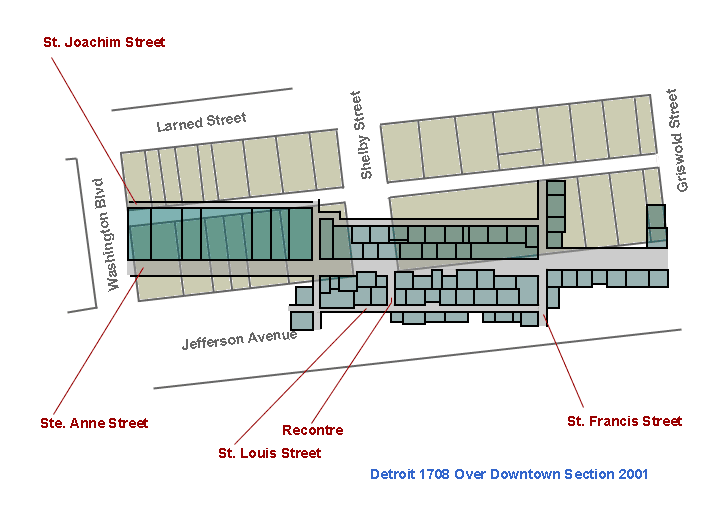Detroit Places:
1708 Land conveyances

To see the name of the person or family to whom a lot was granted, hold your mouse pointer over that lot in the map below (note: this feature may not work for Netscape users; if you have difficulty, please scroll down for a list of landholders with their associated lot number):

Lot #1: Pierre Chesne
Lot #2: Andre Chouet
Lot #3: Pierre Faverau
Lot #4: Joseph Despre
Lot #5: Salomon Joseph du Vestin
Lot #6: Pierre Leger
Lot #7: Bonnaventure Compien
Lot #8: Jacob de Marsac
Lot #9: M. D'Argenteuil
Lot #10: Jean Richard
Lot #11: Jean Labatier
Lot #12: Etienne Bontran
Lot #13: Pierre Hemard
Lot #14: Antoine Dupuis
Lot #15: Jacques L'Anglois
Lot #16: Guillaume Bovet
Lot #17: Michael Masse
Lot #18: Michel Campau
Lot #19: Louis Normand
Lot #20: Francois Tesse
Lot #21: Pierre Chantelon
Lot #22: Francois Bienvenu
Lot #23: Pierre Esteve
Lot #24: Blaise Surgere
Lot #25: Pierre Poirier
Lot #26: Antoine Ferron
Lot #27: Pierre Tacet
Lot #28: Francois Fafard de Lorme
Lot #29: Michel Dizier
Lot #30: Jacob de Marsac
Lot #31: Rencontre
Lot #32: Desloriers
Lot #33: Xaintonge
Lot #34: Jacques du Moulin
Lot #35: Guilleaume Aguet
Lot #36: Louis Gastineau
Lot #37: Joseph Parent
Lot #38: Sirier
Lot #39: Quilenchive
Lot #40: Derance
Lot #41: Du Figuier
Lot #42: La Montagne
Lot #43: Pierre Mallet
Lot #44: Antoine du Fresne
Lot #45: Jean Baptiste Chornic
Lot #46: Jean Casse
Lot #47: Paul L'Anglois
Lot #48: Jerome Marliard
Lot #49: Andre Bombardie
Lot #50: Pierre du Roy
Lot #51: Pierre Roy
Lot #52: Francois Margue
Lot #53: Antoine Magnant
Lot #54: Francois Bonne
Lot #55: Touissaints Dardennes
Lot #56: Pierre Bassinet
Lot #58: Antoine Beauregard
Lot #57: (maybe) Francois Brunet
Lot #59: Marie Le Page
Lot #60: Jacques Campau
Lot #61: Jean Serond
Lot #62: Pierre Robert
Lot #63: L'Arramee
Lot #64: Rene Le Moine
Lot #65: Jacques Le Moine
Lot #66: Paul Guillet
Lot #67: (?) Joseph Rinaud
Lot #68: Antoine Tuffe
